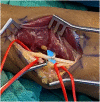Modern Treatment of Cubital Tunnel Syndrome: Evidence and Controversy
- PMID: 37521554
- PMCID: PMC10382899
- DOI: 10.1016/j.jhsg.2022.07.008
Modern Treatment of Cubital Tunnel Syndrome: Evidence and Controversy
Abstract
Cubital tunnel syndrome is the second most common peripheral mononeuropathy in the upper extremity. However, the diagnosis and treatment of cubital tunnel syndrome remains controversial without a standard algorithm. Although diagnosis can often be made from the patient's history and physical examination alone, electrodiagnostic studies, ultrasound, computed tomography (CT), and magnetic resonance image (MRI) can also be useful in diagnosing the disease and selecting the most appropriate treatment option. Treatment options include conservative nonoperative techniques as well as various surgical options, including in situ decompression with or without transposition, medial epicondylectomy, and nerve transfer in advanced disease. The purpose of this review is to summarize the most up-to-date literature regarding cubital tunnel syndrome and propose a treatment algorithm to provide clarity about the challenges of treating this complex patient population.
Keywords: Cubital tunnel syndrome; Electrodiagnostic testing; Nerve compression syndrome; Nerve transfer; Ulnar nerve.
© 2022 The Authors.
Figures

















References
-
- Staples J.R., Calfee R. Cubital tunnel syndrome: current concepts. J Am Acad Orthop Surg. 2017;25(10):e215–e224. - PubMed
-
- Naran S., Imbriglia J.E., Bilonick R.A., Taieb A., Wollstein R. A demographic analysis of cubital tunnel syndrome. Ann Plast Surg. 2010;64(2):177–179. - PubMed
-
- Soltani A.M., Best M.J., Francis C.S., Allan B.J., Panthaki Z.J. Trends in the surgical treatment of cubital tunnel syndrome: an analysis of the national survey of ambulatory surgery database. J Hand Surg. 2013;38(8):1551–1556. - PubMed
Publication types
LinkOut - more resources
Full Text Sources

